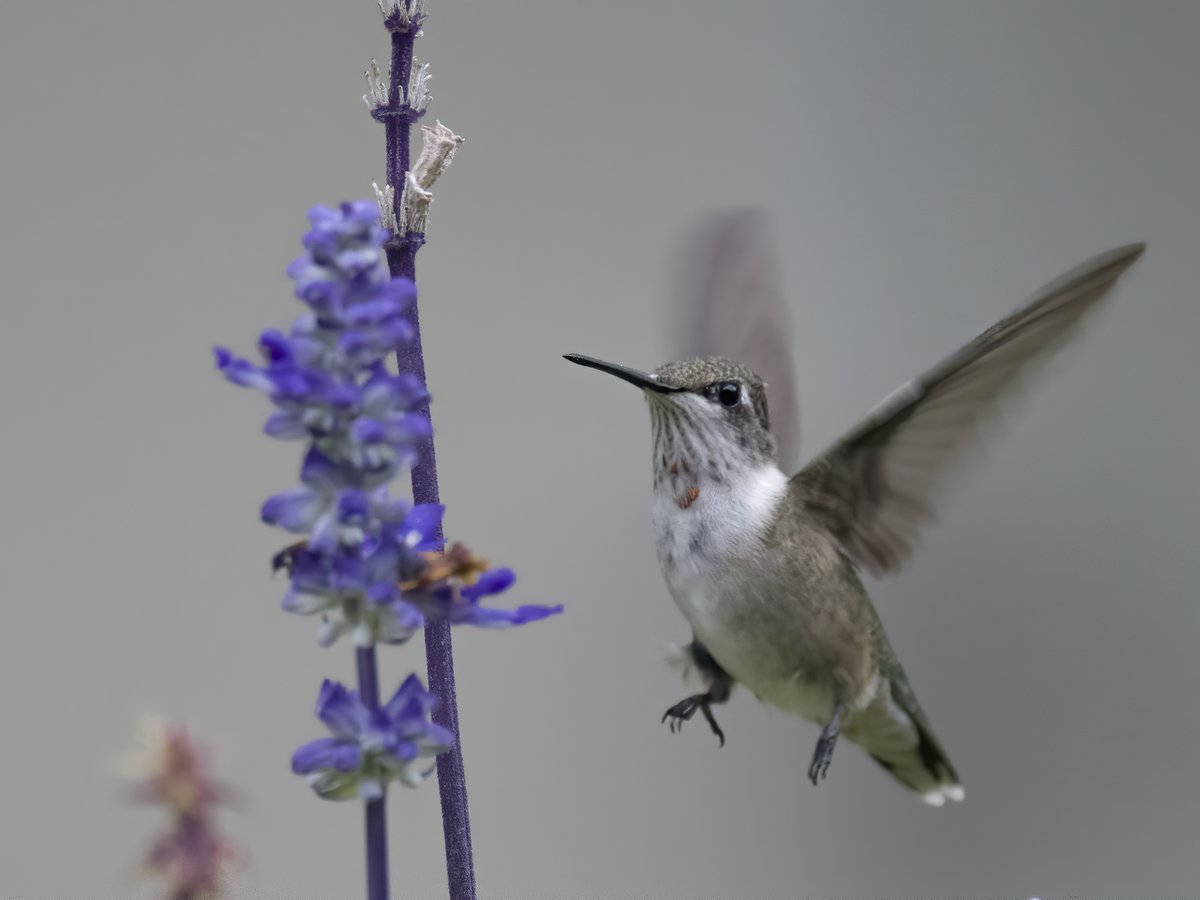Down past the second meadow at the Lindsay-Parsons Biodiversity Preserve, an old snag rises above a dense expanse of successional shrubs. For years now, lucky passersby on sunny spring days have regularly seen a male Ruby-throated Hummingbird here, perching like a little red-badged sentinel at the tip of a branch, zinging away to resume his rounds, then faithfully returning to his post.
Scenes like this will play out in many other preserved lands and feeder gardens throughout our region in coming weeks. Given their familiarity, endearingly diminutive proportions, and distinctive habits, it’s no wonder that Ruby-throated Hummingbirds are among our most iconic and beloved birds. And beyond the features that we can readily see, recent advances in science and technology-aided imaging shed further light on just how amazing their adaptations are.
Hummingbirds are unique among birds in their ability to hover without a headwind, and even to fly backwards and upside down. They achieve these aeronautical feats via distinctive wing mechanics, documented in the past two decades using laser stroboscopy. Unlike other birds, which open their wings on the downstroke and fold them on the upstroke, hummingbirds keep their wings open on both strokes. They twist their wings on flexible shoulder joints in a figure-eight pattern, creating vortices that in turn generate lift.
All this happens far too fast for the unaided human eye to see – about 50-60 wingbeats per second. What’s more, hummingbirds’ hearts thrum at up to 20 beats per second, and even at rest they breathe 250 times per minute. When hummingbirds fly, their oxygen consumption relative to muscle mass is approximately 10 times higher than for top human athletes.
Therefore fueling up is another vitally important, highly evolved aspect of hummingbird life history. Ruby-throated Hummingbirds feed primarily on flower nectar, modestly supplemented by tiny insects and spiders. They have bifurcated tongues with feathery tips and two grooves down the middle. It was long believed that capillary action drew nectar into these grooves passively, but scientists have recently demonstrated via high-speed videography and flow modeling that the tongues actually expand when they touch nectar in a flower, creating forces that actively pump the nectar through the grooves into the bird’s body, up to 20 times per second. The tongue contracts again when it passes back out through the narrow bill tip, ensuring that the nectar remains inside.
Male Ruby-throated Hummingbirds in the breeding season drink nectar every 15 to 20 minutes, alternating feeding sessions with moments of rest and high-intensity flights, courtship displays, and battles with other males. They maintain a very precise energy balance during these times, quickly burning through the sugar that they take in. At night, without blood sugar replenishment, hummingbirds can slow their metabolisms to a profound torpor, allowing their body temperatures to approach ambient air temperatures.
The nest of the Ruby-throated Hummingbird is about the size of a ping-pong ball. The female builds the nest out of plant fibers, scales of buds, and spider silk with lichens for camouflage, on branches 10 to 90 feet above the ground. She lays two eggs, each the size of a small bean. The nests have a distinctive ability to stretch to accommodate growing young. Indeed, fledgling Ruby-throated Hummingbirds are much larger than their parents, reaching around 4.5 grams as opposed to 2.5 to 3 grams for typical breeding adults.
Toward the end of the breeding season, adult Ruby-throated Hummingbirds change their routines and metabolic activity, doubling their body fat percentage and approaching the size of the fledglings. Then, during southward migration, their finely-tuned reliance on frequent sugar intake becomes a total dependence on stored fat. The journey to wintering grounds in Central America can be as long as 2,000 miles, including a nonstop trip of 500+ miles across the Gulf of Mexico.
The closest living relatives of hummingbirds are swifts. Scientists believe that the first hummingbirds evolved about 42 million years ago. Surprisingly, the earliest fossil records of hummingbirds are from Europe, where no hummingbirds remain today. This evidence, combined with DNA analysis, suggests that hummingbirds expanded their range to the Americas, then died out in Eurasia. They became established in South America and radiated into many new species starting around 22 million years ago. Now there are more than 300 hummingbird species. Evolution is thought still to be ongoing. But the Ruby-throated Hummingbird remains the only hummingbird species that regularly occurs in eastern North America.
Thus, the Ruby-throated Hummingbird is much more than a charming little curiosity or a spark of glittering color. It’s a high-revving fuel-switching hybrid hovercraft-rocket offering short-range and long-range settings, plus “economy mode” on-demand – the culmination of millions of years of engineering refinement through evolution, revealed by modern science.


